Konstantin Makovsky
Konstantin Yegorovich Makovsky (Russian: Константин Егорович Маковский; June 20 [O.S. July 2] 1839 —September 17 [O.S. September 30] 1915) was an influential Russian painter, affiliated with the "Peredvizhniki (Wanderers)". Many of his historical paintings, such as Beneath the Crown (1889) also known as The Russian Bride's Attire and Before the Wedding, showed an idealized view of Russian life of prior centuries. He is often considered a representative of Academic art.
Konstantin Makovsky | |
|---|---|
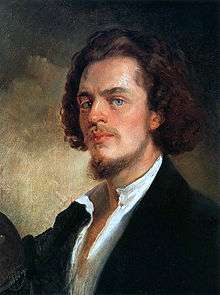 Self-Portrait, c. 1856 | |
| Born | Konstantin Yegorovich Makovsky 20 June 1839 |
| Died | 17 September 1915 (aged 76) |
| Nationality | Russian |
| Education | Member Academy of Arts (1867) Full Member Academy of Arts (1898) |
| Known for | Painting |
| Movement | Realism, Academism |
| Patron(s) | Alexander II of Russia |
Biography
.jpg)
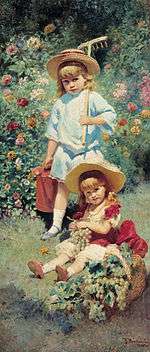
Konstantin Makovsky was born in Moscow. His father was the Russian art figure and amateur painter, Yegor Ivanovich Makovsky. His mother was a composer, and she hoped her son would one day follow in her footsteps. His younger brothers Vladimir and Nikolay and his sister Alexandra also went on to become painters.[1]
In 1851 Makovsky entered the Moscow School of Painting, Sculpture and Architecture where he became the top student, easily getting all the available awards. His teachers were Karl Bryullov and Vasily Tropinin. Makovsky's inclinations to Romanticism and decorative effects can be explained by the influence of Bryullov.
Although art was his passion, he also considered what his mother had wanted him to do. He set off to look for composers he could refer to, and first went to France. Before, he had always been a classical music lover, and listened to many pieces. He often wished he could change the tune, or style of some of them to make them more enjoyable. Later in his life it came true.
In 1858 Makovsky entered the Imperial Academy of Arts in Saint Petersburg. From 1860 he participated in the Academy's exhibitions with paintings such as Curing of the Blind (1860) and Agents of the False Dmitry kill the son of Boris Godunov (1862). In 1863 Makovsky and thirteen other students held a protest against the Academy's setting of topics from Scandinavian mythology in the competition for the Large Gold Medal of Academia; all left the academy without a formal diploma.[1]
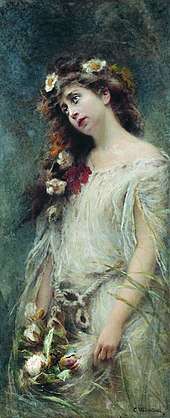
Makovsky became a member of a co-operative (artel) of artists led by Ivan Kramskoi, typically producing Wanderers paintings on everyday life (Widow 1865, Herring-seller 1867, etc.). From 1870 he was a founding member of the Society for Traveling Art Exhibitions and continued to work on paintings devoted to everyday life. He exhibited his works at both the Academia exhibitions and the Traveling Art Exhibitions of the Wanderers.
A significant change in his style occurred after traveling to Egypt and Serbia in the mid-1870s. His interests changed from social and psychological problems to the artistic problems of colors and shape.
In the 1880s he became a fashionable author of portraits and historical paintings. At the World's Fair of 1889 in Paris he received the Large Gold Medal for his paintings Death of Ivan the Terrible, The Judgement of Paris, and Demon and Tamara. He was one of the most highly appreciated and highly paid Russian artists of the time. Many democratic critics considered him as a renegade of the Wanderers' ideals, producing (like Henryk Siemiradzki) striking but shallow works,[2] while others see him as a forerunner of Russian Impressionism.
Makovsky was killed in 1915 when his horse-drawn carriage was hit by an electric tram in Saint Petersburg.
Selected works
_Google_Cultural_Institute.jpg)
 The Bulgarian martyresses
The Bulgarian martyresses Kissing Ceremony
Kissing Ceremony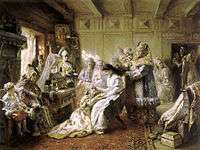 Beneath the Crown/The Russian Bride's Attire/Before the Wedding
Beneath the Crown/The Russian Bride's Attire/Before the Wedding Bride-show
Bride-show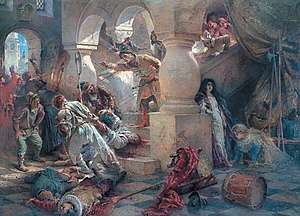 The Murder of False Dmitry
The Murder of False Dmitry The Toilet of Venus
The Toilet of Venus Happy Arcadia
Happy Arcadia The Judgement of Paris
The Judgement of Paris.jpg) Portrait of S. L. Stroganova
Portrait of S. L. Stroganova Portrait of Sergei Stroganov
Portrait of Sergei Stroganov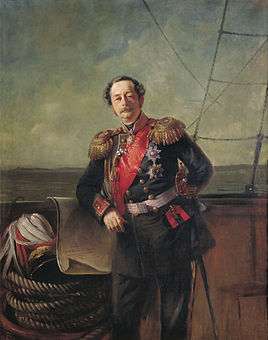 Portrait of Muraviev-Amursky
Portrait of Muraviev-Amursky.jpg) Tsar Alexander II
Tsar Alexander II
See also
References
- "Biography of Konstantin Makovsky". blouinartinfo.com. Blouin. Retrieved 30 October 2015.
- "Константин Маковский" [Konstantin Makovsky]. ГЕЛОС - Библиотека коллекционера [GELOS: Collectors' Library] (in Russian). 17 March 2005.
External links
| Wikimedia Commons has media related to Konstantin Makovsky. |
- Biography on site Hrono.ru (in Russian)
- Official site (in Russian)
- Biography on site gelos.ru (in Russian)
- Biography (in Russian)